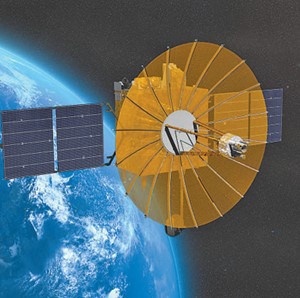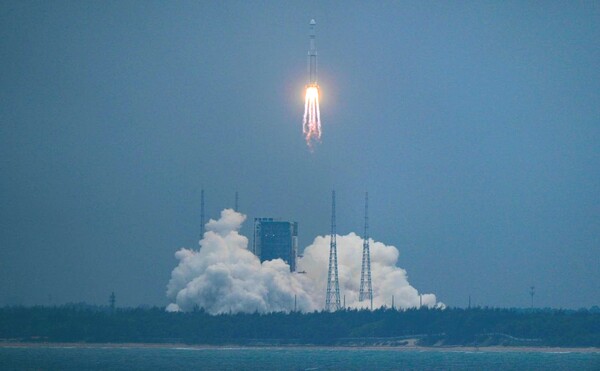By Feng Hua, People's Daily
On March 20, China sent a new relay satellite into space to provide Earth-Moon communications services.
The relay satellite dubbed Queqiao-2, or Magpie Bridge-2, was launched by the Long March-8 Y3 carrier rocket from the Wenchang Space Launch Site in south China's Hainan province at 8:31 a.m. Beijing Time.
"As a 'key link' in the implementation of the fourth phase of China's lunar exploration program, the Queqiao-2 relay satellite will serve as a communications hub," according to Ge Ping, deputy director of the Lunar Exploration and Space Program Center of the China National Space Administration (CNSA).

The fourth phase of China's lunar exploration program, reportedly approved for implementation in December 2021, consists of four missions: Chang'e-4, Chang'e-6, Chang'e-7, and Chang'e-8. Among them, Chang'e-4 was launched in December 2018, achieving the first-ever soft landing and roving exploration on the far side of the moon in the world. Chang'e-6 is scheduled for launch in the first half of this year, while Chang'e-7 and Chang'e-8 will form the basic model of a lunar research station and carry out tasks including exploration of the lunar environment.
Why is it necessary to launch the Queqiao-2 relay satellite?
Experts explained that since the moon always has one side facing away from the Earth, probes landing on the far side of the moon are blocked by the moon itself, making it impossible to directly communicate and transmit data with the measurement-control system on Earth. In this case, a relay satellite is needed to bridge the information connection between ground stations and the lunar probe.
China launched the first relay satellite Queqiao in 2018 to transmit signals between ground stations and the Chang'e-4 probe that landed on the far side of the moon. So far, the Queqiao has been in orbit for many years and has exceeded its designed lifespan.
"The landing and sample collection sites of the fourth phase of China's lunar exploration program are mainly in the lunar south pole region or on the far side of the moon. Therefore, a relay satellite with broader functionality and higher performance is needed to establish a new 'relay communications station' between the moon and Earth to overcome communications and data transmission challenges," Ge said.
Compared with the first Queqiao relay satellite, the Queqiao-2 relay satellite boasts more technological innovations, a broader range of technical capabilities, enhanced functionalities, more complex interfaces, higher development complexity, and a longer mission time span. Besides serving Earth-Moon communications, it also carries multiple scientific payloads and will conduct scientific exploration missions.
According to the CNSA, in addition to the fourth phase of China's lunar exploration program, the Queqiao-2 can also provide Earth-Moon communications services for future domestic and international lunar exploration missions.

When it comes to the Chang'e-6 set to return samples from the far side of the moon, experts said that all 10 lunar sample return missions conducted by humans by far have taken place on the near side of the moon. The far side of the moon is generally older than the near side and contains the Aitken Basin, one of the three major lunar terranes, making it highly valuable for scientific research.
The pre-selected landing area for the Chang'e-6 mission is the South Pole-Aitken Basin on the far side of the moon, thus enabling the probe to discover and collect lunar samples from different regions and ages to help humans learn more about the moon.
Following the successful mission of the Chang'e-6, scientists will conduct systematic and long-term research on the lunar samples from the far side of the moon, analyzing the structure, physical properties, and material composition of the lunar regolith to deepen human understanding of the moon's origin and evolutionary history.
Currently, a new wave of lunar exploration is sweeping across the world, with major spacefaring nations actively engaging in lunar exploration activities.
Ge noted that China has always been attaching importance to international cooperation in its lunar exploration program, and China's door is always open for collaborative efforts, which have been proven by many vivid examples and win-win results in previous lunar exploration missions.
China has initiated the application process for global researchers to study the lunar samples brought back by the Chang'e-5 mission and will openly solicit plans for cooperation in the following tasks of the fourth phase of the lunar exploration program and the planetary exploration program, according to Ge.
The CNSA said the Chang'e-6 mission will carry a radon gas detector from France, a negative ion detector from the European Space Agency, a laser retroreflector from Italy, and Pakistan's CubeSat.
At the same time, China is speeding up efforts to build the International Lunar Research Station, a mega science project, and hopes that more international partners will join in this endeavor to expand humanity's cognitive frontiers and contribute to the peaceful use of outer space and the building of a community with a shared future for mankind.


